Printing
Results
Brightness and Contrast Ratio
For those who have a need to match colors between their computer displays, cameras, and printers, what works well for computing purposes often isn't the best suited for doing other image related work. To help people who work in such areas match their computer colors to their paper colors better, standards were established. For print work, the standard is a gamma of 2.2, a black point of 0.60 nits, and a white point of 100 nits. We attempt to calibrate all the monitors for these settings.
Finding the appropriate settings to reach these levels can be a time-consuming process for some of the displays. It may require numerous iterations through the calibration process to end up with the desired white point, and on some LCDs it might not even be possible to reach a satisfactory result (though that hasn't occurred yet). The nature of LCDs is such that we are unable to get both an accurate white point and an accurate black point according to printing requirements (our black levels always ended up darker than they are supposed to be), but we did manage to get near the desired 100 nits white point on all of the tested displays. For the Samsung 245T, we used brightness/contrast settings of 13/75, with RGB at 16/21/36. We tried several other settings, but all others scored worse so we settled on these values.
For reference, we have included the target value in the following graphs, so the greater the deviance of a display from the targeted value, the less suitable (in theory) a display becomes for print work.
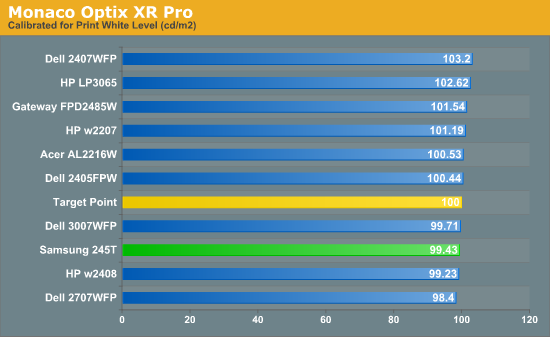
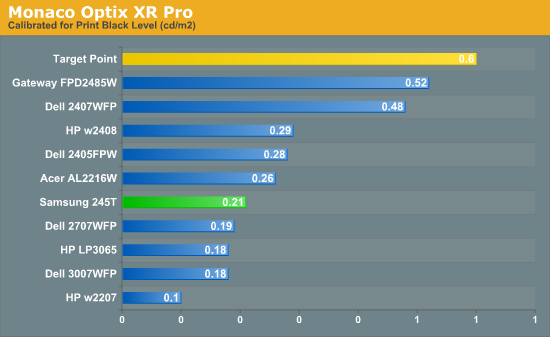
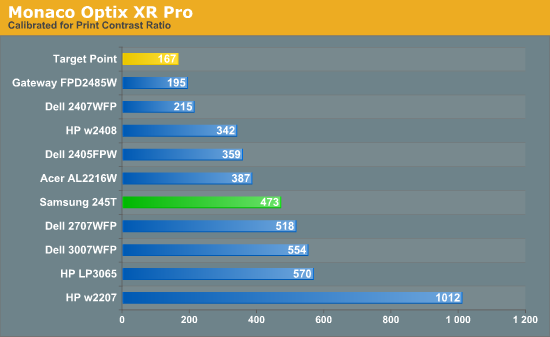
Since very slight differences in brightness are not a huge deal, we did not attempt to get 100% accuracy on the white point, but further tuning of the various displays would have made it possible to get closer to 100 nits. The primary goal was to get the white point near 100 nits. The target black point is impossible to achieve once we have reached the target white point with any LCD that we have tested to date - and we expect that trend to continue. Due to the reduced brightness, contrast ratios are often lower, but that is inherent with the target settings. The Samsung 245T is pretty average when it comes to "calibrate for print" brightness and contrast ratio.
Color Accuracy
Given the importance of accurate colors for printing work, we need to adjust the desired Delta E scale. A Delta E of less than 1.0 is definitely the goal here, and 1.0 to 2.0 is merely acceptable. Scores above 2.0 generally mean a display is not fit for printing professionals.
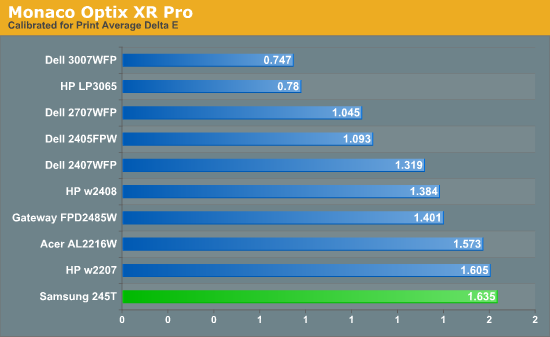
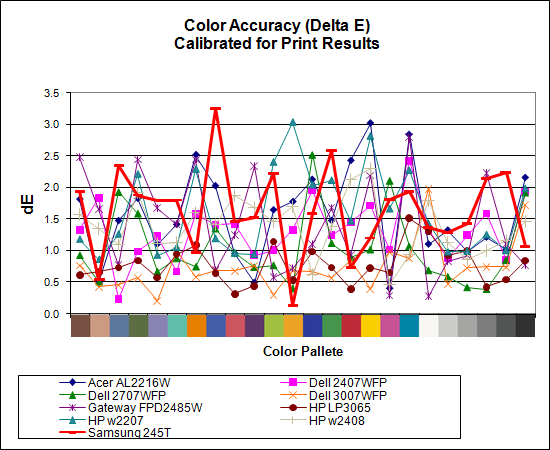
At the reduced brightness setting used in this test, the Samsung 245T doesn't score as well as it does in other areas. In fact, it's technically the worst LCD we've tested so far -- at least in terms of raw score -- when it comes to calibrating the display for print work. Considering that all of the displays do reasonably well in this test, however, this probably isn't a big enough concern that we would strongly recommend a different display, other than one of the 30" LCDs on the market. Whether it's their use of S-IPS panels or something else, we can't say, but the 30" LCDs that we've tested have the lowest Delta E scores of any of the monitors.










60 Comments
View All Comments
AnnonymousCoward - Monday, February 11, 2008 - link
Jarred, Jarred, Jarred...IMHO, this monitor is total garbage and unusable due to input lag. I don't think you should shrug it off since you can't detect it, as it is a big issue for many people.
Check out this great chart: http://www.tftcentral.co.uk/images/samsung_xl20/in...">http://www.tftcentral.co.uk/images/samsung_xl20/in...
You talked about measuring input lag...well, it's true that 2 DVI output ports could have a lag between the two, but we notice that they don't since the chart shows lags ranging from 1.6ms to 58.8ms (taken from average readings). That data validates user experiences, as well. Other sources have found that the 244T/245T have 55-65ms of input lag, and that the ports don't matter: http://tinyurl.com/2xl857">http://tinyurl.com/2xl857
Even if you can't perceive that, think about it in terms of ping. Is a 60ms ping the same as 120ms? This monitor effectively adds 60ms to your ping! And regardless of games, this isn't at all acceptable to me for a mouse cursor in Windows; the delayed feedback makes it harder to precisely point at anything.
Thanks anyway for the review, and normally I enjoy your writings.
JarredWalton - Monday, February 11, 2008 - link
Here's the problem with that chart of input lag:The GPU sends out a signal, at 60Hz. That means that the display gets a new image every 1/60s. So you can measure an input lag of 17ms, 33ms, 50ms, 67ms, 83ms, etc. What you can't measure are input lags of 2ms, 5ms, or any other value... unless the testing methodology itself is unsound.
They're taking an average, but an average of what? "We have 20 pictures that show no input lag and 20 pictures that show 1 frame of lag. That makes the average lag half a frame = 8.3ms." If the margin of error (due to output synchronization) is 1 frame - and it is in my testing - then lag is either undetectable, ~1 frame, ~2 frames, etc.
It could very well be that the 245T has worse lag than other displays. I don't have access to most of the displays they've tested, and I don't have any CRTs. I can compare results to a 2407WFP or 3007WFP, or maybe a couple other LCDs. However, the baseline would be inherently different.
I talked about the question http://www.anandtech.com/displays/showdoc.aspx?i=2...">here and later http://www.anandtech.com/displays/showdoc.aspx?i=2...">here, and at that point I decided that the methodology and reliability (with clearly different screen refreshes taking place in pictures) made the whole process virtually meaningless, so I stopped doing it.
If you want a figure of approximate lag, I can try to put a number of frames "lag" with a margin of error of 1. So anything less than one is apparently "equal" - which is what I found in every test I tried previously. To do an average is misleading - or at least an abstraction that hides the inherent flaws in the testing methodology - so I won't do that.
nevbie - Tuesday, February 12, 2008 - link
I don't know if this is reasonable - but if I were to think a way to measure input lag, it wouldn't be a comparison of clone moded monitors where other is a CRT and other is the subject.Instead I'd like to measure the time difference between pressing a button (mouse/keyboard) and a change that occurs on the screen. This is what people care about anyway. Of course such measurement would also count all the other delays caused by system, not just monitor only. (Now that sounds interesting, at least from a gamer standpoint!)
How to do it? I don't know. A combination of a device that sends a signal to the PC and "photographes" the LCD (or part of it) would do it (constantly photographes for some time, after input given to the PC). Software-wise, a program that keeps the screen black and waits for input, and turns it red if it gets the input would be enough. Perhaps a modded caliberator could be used (dunno about their functionality). With such system you could even measure lag caused by other hardware, let's say multi-GPU (if such lag exists, that is).
Just my thoughts..
AnnonymousCoward - Tuesday, February 12, 2008 - link
I agree with your theory, that input lag measurements should be in increments of 1/60s. For some reason, that's never how the measurements play out.I found just what you asked for: 70 data points from 7 monitors, graphed. http://tinyurl.com/2gajok">http://tinyurl.com/2gajok http://tinyurl.com/rgx9n">http://tinyurl.com/rgx9n
Looking at the data, I think it's reasonable to take the average of 10 readings, in spite of unknown measurement inaccuracies. Those averages give pretty good information about the real-world lag versus a CRT.
Here's an easy test you can do to expose the lag: move your mouse across the screen in an abrupt, sharp sweep. Compare when the sound of the mouse against the table ceases, versus when the cursor stops moving.
jimmy43 - Thursday, February 7, 2008 - link
I tend to agree on most points with you. However, input lag IS a real issue. For example, I use a monitor with 16ms refresh time and it doesnt bother me at all, while it would drive other people nuts. The same goes for input lag, and certain people's sensitivies.Incidentaly, the 244T had input lag so terrible I read countless reports of them being returned because they were completely unusable. This is from many different sources on many different sites. So the first thing I wanted to know about the 245T was weather or not it addressed this issue.
If you could, at the very least, just throw something about it in the subjective area then that would be helpful.
JarredWalton - Thursday, February 7, 2008 - link
Subjectively, I didn't notice anything related to lag compared to other LCDs. But if I'm not susceptible to that.... :)JarredWalton - Thursday, February 7, 2008 - link
And I added a note on the subjective evaluation for you.PPalmgren - Friday, February 8, 2008 - link
Input lag is the main thing I look for in LCD monitor reviews, and no one seems to want to cover it. It is the ultimate buying point for me. I "upgraded" from a Viewsonic VX922 to a NEC 2470WNX and the input lag made me put my 19 inch back of my desk. I mainly play RTSes and clicking accuracy is very important. When using the WNX I had major problems because of the delay, destroying my ability to click accurately on small things at high speed. In order to click dead-on, you have to guess your mouse distance exactly and click before the pointer shows up there on the screen. The input delay feels to be about 2-3 frames difference between my monitors. I currently have them both hooked up and use nView to switch between them now.Would it be possible to set a computer up for dualview and compare reviewed monitors side-by-side with a known well performer to measure input lag through a photo, etc? I think it would be a great thing for reviews. Since my purchase I've built 2 machines for customers who wanted 24'' monitors, and I've tested each of them with the same results (HP2408, Dell2407).
jimmy43 - Thursday, February 7, 2008 - link
I tend to agree on most points with you. However, input lag IS a real issue. For example, I use a monitor with 16ms refresh time and it doesnt bother me at all, while it would drive other people nuts. The same goes for input lag, and certain people's sensitivies.Incidentaly, the 244T had input lag so terrible I read countless reports of them being returned because they were completely unusable. This is from many different sources on many different sites. So the first thing I wanted to know about the 245T was weather or not it addressed this issue.
If you could, at the very least, just throw something about it in the subjective area then that would be helpful.
LTG - Thursday, February 7, 2008 - link
Good intro on the base panel technologies.It would be interesting to know what is used for most LCD TVs (52", 65").
I don't notice it mentioned usually.